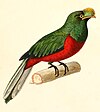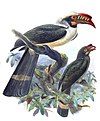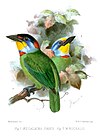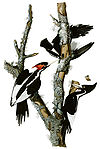Mulleripicus
Appearance
| Mulleripicus | |
|---|---|

| |
| A pair of ashy woodpeckers (Mulleripicus fulvus) | |
| Scientific classification | |
| Domain: | Eukaryota |
| Kingdom: | Animalia |
| Phylum: | Chordata |
| Class: | Aves |
| Order: | Piciformes |
| Family: | Picidae |
| Tribe: | Picini |
| Genus: | Mulleripicus Bonaparte, 1854 |
| Type species | |
| Picus pulverulentus[1] Temminck, 1826
| |
| Species | |
|
see text | |
Mulleripicus is a genus of birds in the woodpecker family Picidae. They are found in South and Southeast Asia. The genus forms part of the woodpecker subfamily Picinae and has a sister relationship to the genus Dryocopus whose species are widely distributed in Eurasia and the Americas.
Taxonomy
[edit]The genus Mulleripicus was erected by the French naturalist Charles Lucien Bonaparte to accommodate the great slaty woodpecker (Mulleripicus pulverulentus).[2] The genus name honours the German naturalist Salomon Müller,[3] The genus belongs to the tribe Picini and is a member of a clade that contains the five genera: Colaptes, Piculus, Mulleripicus, Dryocopus and Celeus.[4]
The genus contains four species.[5]
| Common name | Scientific name and subspecies | Range | Size and ecology | IUCN status and estimated population |
|---|---|---|---|---|
| Ashy woodpecker | Mulleripicus fulvus (Quoy & Gaimard, 1832) |
Sulawesi and surrounding islands in Indonesia | Size: Habitat: Diet: |
LC
|
| Northern sooty woodpecker | Mulleripicus funebris (Valenciennes, 1826) |
Luzon, Marinduque, Catanduanes and the Polillo Islands in the Philippines | Size: Habitat: Diet: |
NT
|
| Southern sooty woodpecker
|
Mulleripicus fuliginosus Tweeddale, 1877 |
Mindanao, Leyte, and Samar | Size: Habitat: Diet: |
VU
|
| Great slaty woodpecker | Mulleripicus pulverulentus (, ) |
Bangladesh, Bhutan, Brunei, Cambodia, India, Indonesia, Laos, Malaysia, Myanmar, Nepal, the Philippines, Singapore, Thailand and Vietnam
|
Size: Habitat: Diet: |
LC
|
References
[edit]- ^ "Picidae". aviansystematics.org. The Trust for Avian Systematics. Retrieved 2023-07-26.
- ^ Bonaparte, Charles Lucien (1854). "Quadro dei volucri zigodattili ossia passeri a piedi scansori". In de Luca, Serafino; Müller, D. (eds.). L'Ateneo Italiano; raccolta di documenti e memorie relative al progresso delle scienze fisiche (in Italian). Vol. 2. Parigi [Paris]: Victor Masson. pp. 116–129 [122].
- ^ Jobling, James A. (2010). The Helm Dictionary of Scientific Bird Names. London: Christopher Helm. p. 261. ISBN 978-1-4081-2501-4.
- ^ Shakya, S.B.; Fuchs, J.; Pons, J.M.; Sheldon, F.H. (2017). "Tapping the woodpecker tree for evolutionary insight". Molecular Phylogenetics and Evolution. 116: 182–191. Bibcode:2017MolPE.116..182S. doi:10.1016/j.ympev.2017.09.005. PMID 28890006.
- ^ Gill, Frank; Donsker, David; Rasmussen, Pamela, eds. (2020). "Woodpeckers". IOC World Bird List Version 10.1. International Ornithologists' Union. Retrieved 17 May 2020.











